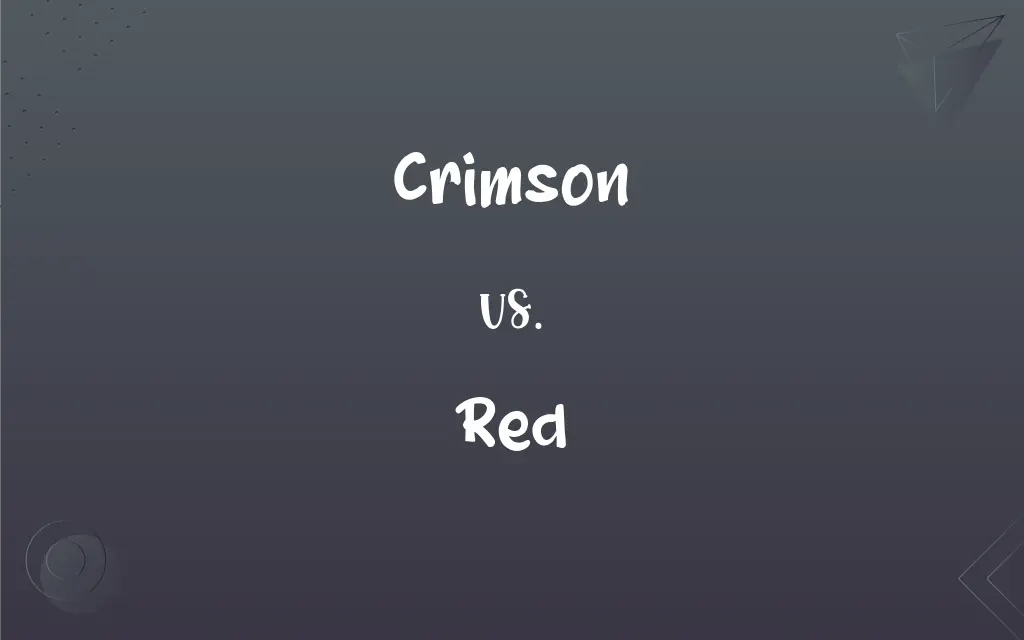Crimson vs. Red: What's the Difference?
Edited by Janet White || By Harlon Moss || Published on January 10, 2024
Crimson is a deep, vivid red color, often with a slight purplish tint, whereas red is a primary color spanning a wider spectrum from light to dark shades.

Key Differences
Crimson is a specific shade of red, characterized by its deep, rich hue with a hint of purple. In contrast, red is a primary color that includes a broad range of shades from light to dark.
The term "crimson" often conveys a sense of luxury or intensity, due to its deep and vibrant quality. Red, however, is more general and can represent a variety of emotions and meanings, from danger to love.
In nature, crimson is less common and usually appears in certain flowers and birds. Red, being a primary color, is more prevalent and seen in a wide array of natural elements.
In the world of fashion and design, crimson is used for a bold, elegant statement. Red, with its various shades, offers more versatility and is used in a wider range of contexts.
In symbolism, crimson often represents nobility and power, due to its association with blood and richness. Red, being more versatile, symbolizes a wider range of concepts from passion to danger.
ADVERTISEMENT
Comparison Chart
Shade Description
Deep, vivid red with a purplish tint
A primary color with a broad spectrum
Common Associations
Luxury, intensity, nobility
Emotions like love, danger, excitement
Prevalence in Nature
Less common, found in specific flowers
Widespread in flora, fauna, and sunsets
Use in Fashion & Design
Bold, elegant, often in formal wear
Versatile, used in various contexts
Symbolic Meanings
Power, nobility, sometimes mourning
Passion, danger, celebration
ADVERTISEMENT
Crimson and Red Definitions
Crimson
Often associated with luxury and opulence.
The ballroom was decorated in shades of gold and crimson.
Red
Often symbolizes passion, love, or danger.
The red heart on the card symbolized love.
Crimson
Symbolic of power and nobility in historical contexts.
The king's robes were a striking shade of crimson.
Red
Used in various cultural contexts to signify different emotions and events.
Red is often worn during celebrations in many cultures.
Crimson
In literature, used to convey deep emotions or intensity.
Her cheeks turned crimson with embarrassment.
Red
Commonly seen in nature, from flowers to sunsets.
The red leaves in autumn create a breathtaking view.
Crimson
A deep, rich red color with a slight purple undertone.
The crimson sunset bathed the sky in a warm, deep hue.
Red
A primary color that can range from light to dark shades.
The red apple was ripe and ready to eat.
Crimson
Represents the color of some flowers and birds.
The garden was full of crimson roses.
Red
A color frequently used in warning signs and signals.
The red stop sign signaled the driver to halt.
Crimson
A deep to vivid purplish red to vivid red.
Red
The hue of the long-wavelength end of the visible spectrum, evoked in the human observer by radiant energy with wavelengths of approximately 630 to 750 nanometers; any of a group of colors that may vary in lightness and saturation and whose hue resembles that of blood; one of the additive or light primaries; one of the psychological primary hues.
Crimson
To make or become deeply or vividly red.
FAQs
Is crimson a natural color?
Yes, crimson is found in nature, notably in flowers like roses and certain birds.
Is crimson warmer than red?
Crimson can appear warmer due to its depth and slight purple undertone.
What does red symbolize in different cultures?
Red can symbolize everything from luck and happiness to caution and danger, depending on the culture.
Is red a common color in branding?
Yes, red is popular in branding due to its visibility and association with energy.
Can crimson be used in interior design?
Yes, crimson can create a sense of depth and luxury in interior design.
What is the origin of the word "crimson"?
The word "crimson" originated from the Old Spanish term "carmesí," which means deep red.
What's the difference in use between red and crimson in art?
Crimson is often used for dramatic, rich highlights, while red is more versatile.
Can red and crimson be used interchangeably?
While both are red, crimson specifically refers to a deeper, more vivid shade.
How is crimson perceived in fashion?
In fashion, crimson is seen as bold and elegant, often used in formal wear.
What emotions does red evoke?
Red can evoke a range of emotions, including excitement, passion, and urgency.
What's the best way to combine red and crimson in design?
They can be combined for a dynamic and layered red palette.
Are there flowers that are naturally crimson?
Yes, such as certain roses and tulips.
Can crimson be lightened?
Crimson can be lightened, but it may lose its characteristic depth.
What does red indicate in traffic lights?
In traffic lights, red universally means stop.
How do red and crimson differ in RGB color models?
Crimson has specific RGB values, whereas red ranges more broadly within the model.
Do red and crimson have the same cultural significance?
Their cultural significance can overlap, but crimson often has more specific associations.
Does red have specific meanings in flags?
In flags, red often symbolizes bravery, strength, and valor.
Why is crimson associated with nobility?
Historically, crimson dyes were rare and expensive, making them a symbol of wealth and power.
Is crimson used in religious symbolism?
Yes, in some religions, crimson represents martyrdom or sacredness.
Is there a psychological impact of red?
Red can increase heart rate and create a sense of urgency or excitement.
About Author
Written by
Harlon MossHarlon is a seasoned quality moderator and accomplished content writer for Difference Wiki. An alumnus of the prestigious University of California, he earned his degree in Computer Science. Leveraging his academic background, Harlon brings a meticulous and informed perspective to his work, ensuring content accuracy and excellence.
Edited by
Janet WhiteJanet White has been an esteemed writer and blogger for Difference Wiki. Holding a Master's degree in Science and Medical Journalism from the prestigious Boston University, she has consistently demonstrated her expertise and passion for her field. When she's not immersed in her work, Janet relishes her time exercising, delving into a good book, and cherishing moments with friends and family.

































































